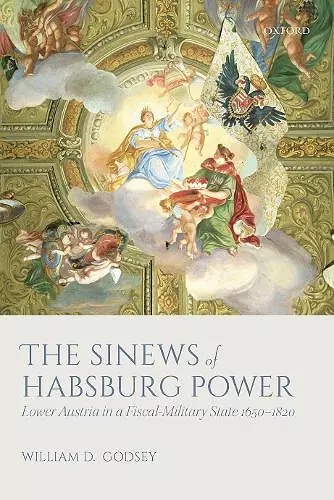The Sinews of Habsburg Power
Lower Austria in a Fiscal-Military State 1650-1820
Format:Hardback
Publisher:Oxford University Press
Published:11th Jan '18
Currently unavailable, and unfortunately no date known when it will be back

The Sinews of Habsburg Power explores the domestic foundations of the immense growth of central European Habsburg power from the rise of a permanent standing army after the Thirty Years' War to the end of the Napoleonic wars. With a force that grew irregularly in size from around 25,000 soldiers to as many as half a million in the War of the Sixth Coalition, the Habsburg monarchy participated in shifting international constellations of rivalry from western Europe to the Near East and in some two dozen, partly overlapping armed conflicts. Raising forces of such magnitude constituted a central task of Habsburg government, one that ultimately required the cooperation of society and its elites. The monarchy's composite-territorial structures in the guise of the Lower Austrian Estates -- a leading representative body and privileged corps -- formed a vital, if changing, element underlying Habsburg international success and resilience. With its capital at Vienna, the archduchy below the river Enns (the historic designation of Lower Austria) was geographically, politically, and financially a key Habsburg possession. Fiscal-military exigency induced the Estates to take part in new and evolving arrangements of power that served the purposes of government; in turn the Estates were able in previously little-understood ways and within narrowing boundaries to preserve vital interests in a changing world. The Estates survived because they were necessary, not only thanks to their increasing financial potency, but also because they offered a politically viable way of exacting ever-larger quantities of money, men, and other resources from local society. These circumstances would persist as ruling became more regularized, formalized, and homogenized, and as the very understanding of the Estates as a social and political phenomenon was evolving.
The implications of Godsey's arguments ... extend well beyond the confines of Lower Austria. The book is highly suggestive on a whole range of important aspects of early modern European history. Any early modern historian would benefit from reading this outstanding work. * Hillary Zmora, Central European History *
Overall Godsey has produced an impressive history of the interdependence of central government and provincial Estates from a long term perspective. He shows why, despite the increasing requirements, the Austrian system of war finance not only did not trigger a political crisis, but also operated in a way that stabilized the system. His study enriches both the historiography of the Habsburg Monarchy and that on early modern state formation and war finance * Simon Karstens, Zeitschrift für Historische Forschung *
[Godsey] delves deeply into the profound fiscal (as well as logistical) support that [the Estates] literally lent to the ever-growing Habsburg military; far from being overpowered or 'emasculated' along the road to absolutism, they proved to be indispensable partners in building the 'sinews of Habsburg power' ... Godsey should be congratulated for ... this bold and innovative study. * Charles Ingrao, American Historical Review *
[Previous] work already demonstrated that the supposedly ramshackle Habsburg monarchy proved surprisingly resilient throughout the tough conflicts from the seventeenth to early nineteenth centuries, but so far we have lacked a clear explanation of how this was achieved. William Godsey's splendid new book goes a long way towards providing that missing answer. * Peter Wilson, English Historical Review *
Godsey's outstanding and fundamental study emphatically shows that 'central power' in the Habsburg composite monarchy did not develop against the Estates, but rather thanks to them. * Franz Leander Fillafer, Historische Zeitschrift *
Godsey's book is a tremendous achievement, and in particular, it will challenge historians of the later Habsburg Monarchy to re-think some of their assumptions about how it functioned over the long term. * Laurence Cole, University of Salzburg, European History Quarterly *
What has been lacking is a long-term study of how provincial institutions worked, and how they fitted into the larger picture. William Godsey's Sinews of Habsburg Power provides a thorough and persuasive response to this need. ... With this important book, Lower Austria becomes a model for understanding why the Estates continued to have an essential role in the Austrian system. * James D. Tracy, Austrian History Yearbook *
- Winner of Winner of the 2018 Arenberg European History Prize Jelavich Book Prize Honorable Mention for 2019.
ISBN: 9780198809395
Dimensions: 243mm x 164mm x 33mm
Weight: 876g
482 pages